Timing mechanism drive parts
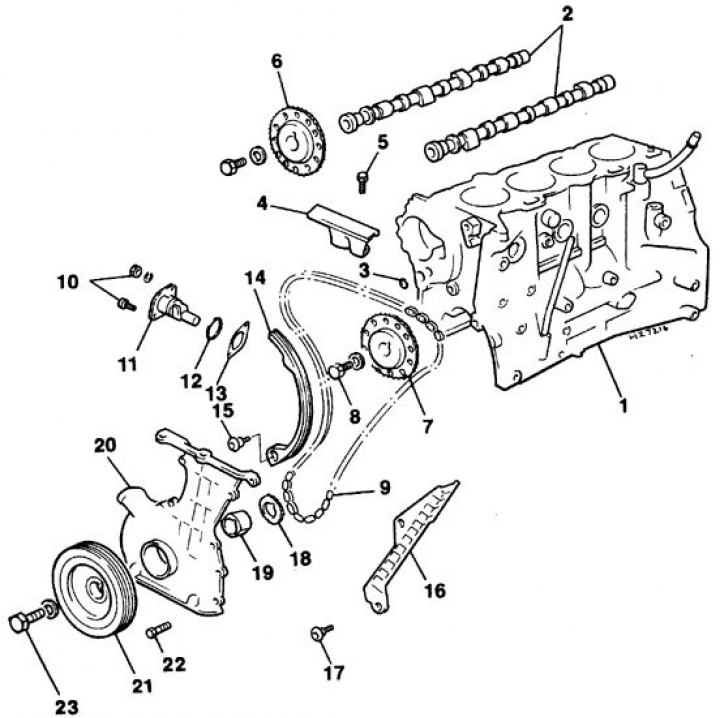
1. Cylinder block; 2. Camshafts; 3. O-ring; 4. Upper chain guide; 5. Upper guide bolt; 6. Intake camshaft sprocket; 7. Exhaust camshaft sprocket; 8. Camshaft sprocket bolt; 9. Chain; 10. Nut and bolt of the chain tensioner; 11. Tensioner; 12. O-ring; 13. Gasket; 14. Tensioner shoe; 15. A bolt of an axis of a shoe of a tensioner; 16. Calm; 17. Stabilizer bolt; 18. Crankshaft drive sprocket; 19. Remote bushing for oil pump drive; 20. Camshaft chain drive cover; 21. Crankshaft pulley; 22. Chain drive cover bolt; 23. Crankshaft pulley bolt
Removing
1. Set the piston of the 1st cylinder to the TDC of the compression stroke (see subsection 3.1.1.3).
2. Remove the cylinder head cover (see subsection 3.2.1.4).
3. Remove the camshaft timing chain cover (see subsection 3.2.1.6).
4. Remove the oil filter (see subsection 2.2.1). If the filter is damaged during removal, replace the filter.
5. Turn away nuts and bolts of fastening and get a chain tensioner. Remove the tensioner ring.
Attention! When removing the tensioner, rotation of the crankshaft is not allowed.
 | 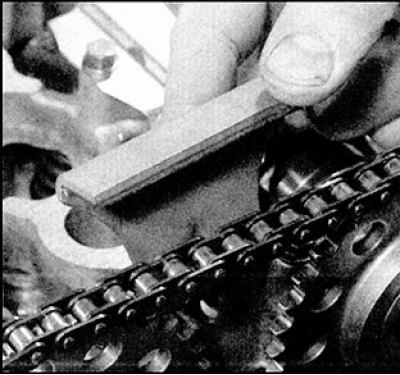 |
6. Loosen the mounting bolts and remove the upper chain guide from the top of the cylinder head.
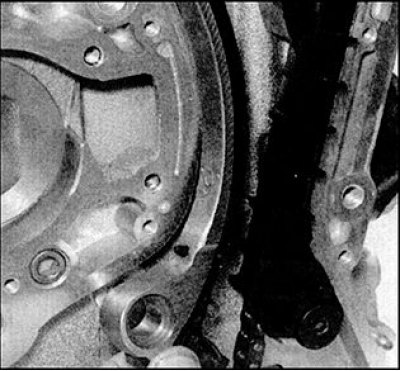
7. Remove the chain tensioner shoe axle bolt and remove the shoe from the cylinder block.
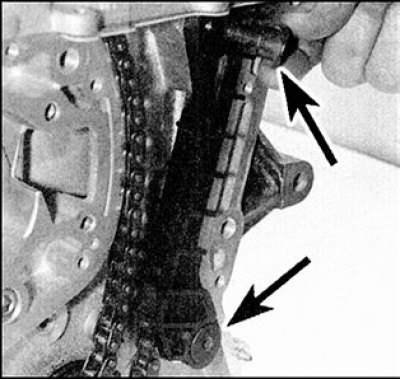 | 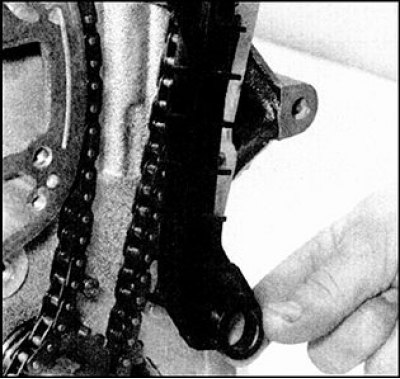 |
8. Loosen and remove the bolts (arrows) and remove the dampener.
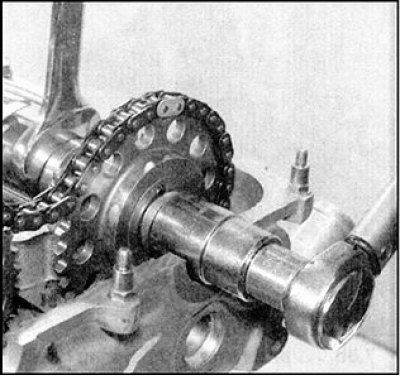
9. Loosen the camshaft sprocket bolts by holding each of the camshafts with an open end wrench by the flats at the front, remove each of the bolts along with the washer.
10. Remove sprockets from camshafts. When loosening the dowel pins at the ends of the camshafts, remove the pins and store with the sprockets.
11. Remove the chain from the crankshaft drive sprocket.
12. If necessary, remove the sprocket from the crankshaft, after paying attention to the correct position of the sprocket, and remove the key (when loosening the key in the crankshaft groove). Store the key with the drive sprocket.
Status check
1. Check the drive and two driven sprockets for signs of wear and defects such as chipping, hooking or missing teeth. If any of the listed signs of wear and damage are found, all sprockets, as well as the chain, should be replaced as a set.
2. Inspect the chain links, check the wear of the rollers. The degree of chain wear can be determined by the deflection in the horizontal plane. There is almost no deflection in the new chain. If there is noticeable axial play in the chain links, then the chain should be replaced. Keep in mind that regardless of the presence of external signs of wear, the chain should also be replaced after a significant mileage, or if a noticeable noise is heard from the running engine from the chain. It is highly recommended to change the chain complete with sprockets, as installing a new chain on worn sprockets, or vice versa, leads to increased wear of the new part and is not justified in terms of costs. If the condition of the chains and sprockets is in doubt, then seek qualified advice from a Nissan car service.
3. Check for signs of wear or damage on the guide and chain guide at the point of contact with the chain, if defects are found, replace these parts.
4. The condition of the tensioner can only be assessed by comparison with a new part. If the condition of the tensioner inspires at least a slight doubt, then it should be replaced.
Installation
1. Check that the piston of the 1st cylinder is still at TDC on the compression stroke (The keyway on the crankshaft toe must point vertically upwards as viewed from the right side of the engine). Insert the key into the groove on the crankshaft toe.
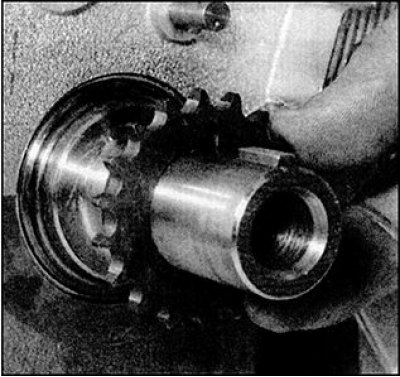
2. Correctly orient the crankshaft drive sprocket (the alignment mark on the sprocket must face away from the crankshaft and the groove in the sprocket must be aligned with the key) and put on the crankshaft.
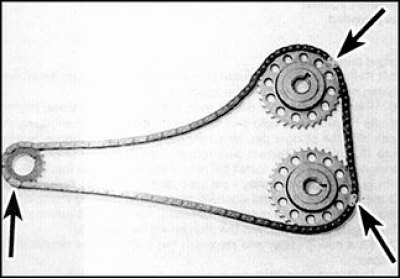
3. There are three color-coded links in the chain (indicated by arrows), each corresponding to a different setting mark. The two links that are closest to each other correspond to the timing marks of the camshafts, the third link must match the timing mark of the crankshaft drive sprocket.
Attention! On some vehicles, the chain links that match the camshaft sprocket timing marks may be a different color from the link that matches the drive sprocket timing mark.
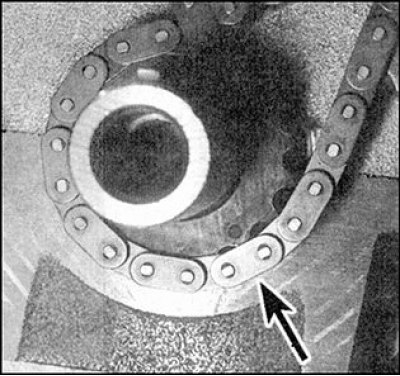
4. Orient the chain so that the color-coded links point outward and are opposite the corresponding timing marks, drive the chain onto the drive sprocket, aligning the highlighted link (arrow) with an asterisk mark.
5. Install the driven sprockets on the intake and exhaust camshafts with the alignment marks on the sprockets facing out.
Attention! Both stars are the same.
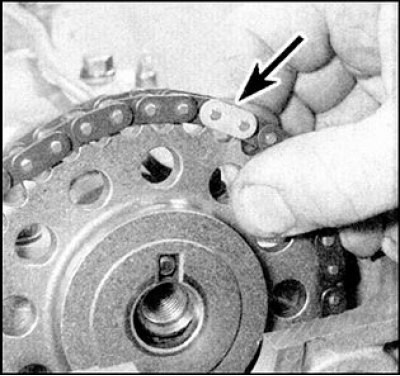
6. put on the chain (arrow) onto the exhaust camshaft sprockets so that the colored links align with the timing marks.
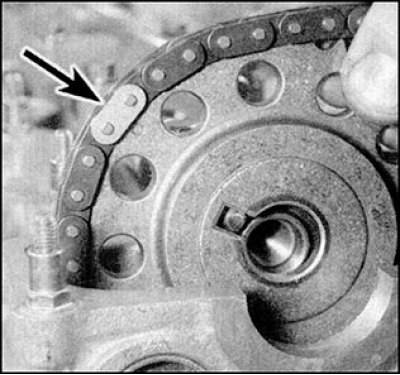
7. Then put on the chain (arrow) onto the intake camshaft sprockets, matching the color-coded links with the alignment marks.
8. Insert dowel pins into the ends of the camshafts (if filmed), align the slots in the sprockets with the dowel pins. Make sure the color-coded links align with the corresponding sprocket alignment marks. Otherwise, remove the chain from the sprockets and make the necessary adjustments.
9. After aligning the alignment marks with the corresponding chain links, tighten the camshaft sprocket bolts by putting washers on the bolts.
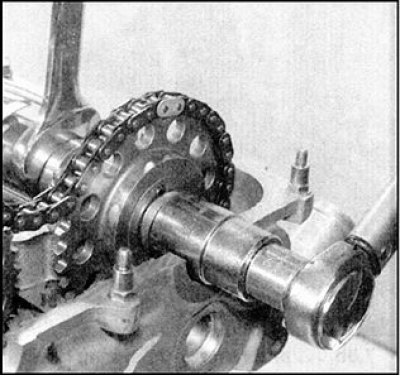
10. Tighten the bolts to the specified torque. During tightening, do not allow the camshaft to turn by holding it by the flats with an open-end wrench.
11. Install the damper and tighten the damper bolt to the specified torque.

12. Install the chain tensioner shoe and tighten the shoe axle bolt to the specified torque.
13. Install the upper chain guide to the cylinder head, tighten the bolts to the specified torque.

14. Release tensioner release lever (1), push the plunger inside the body and fix it in this position with a hook, throwing it over the plunger pin (2).

15. Install a new gasket on the tensioner flange, and put a new o-ring in the housing groove.

16. Install the tensioner, making sure the arrow on the flange points away from the cylinder head. Put on the washers and tighten the tensioner nuts to the specified torque. After tightening the nuts, the mounting hook should automatically disengage from the pin, releasing the plunger.
17. Install a new oil filter and fill the engine with oil (see subsection 2.2.1).
18. Install the chain drive cover (see subsection 3.2.1.6).
19. Install the cylinder head cover (see subsection 3.2.1.4).